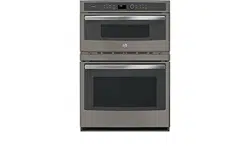Documents: Go to download!
- Owner's manual - (English, Spanish)
- USING THE OVEN
- CARE AND CLEANING
- TROUBLESHOOTING TIPS
Table of contents
User Manual
USING THE OVEN
Oven Controls
Common Controls
- Timer On/Off: Works as a countdown timer. Press the Timer On/Off pad, select the timer type (hours and minutes or minutes and seconds), use the selector dial to set the time, and press the selector dial to start the timer countdown. The oven will continue to operate when the timer countdown is complete. To turn the timer off, press the Timer On/Off pad.
- Settings / Lock Controls: Find oven options for: Help, Clock Settings, Display Mode, Auto Conversion, Auto Shut Off, Beeper Volume, Reminder, Temperature Units, Thermostat Adjust and Oven Information under this selection. See the Oven Settings section for more details. Press and hold Settings pad for 3 seconds to lock or unlock the controls. This locks out the control so that pressing any of the control pads does not activate the feature. Clear/Off is always active, even when the control is locked.
- Selector Dial: The selector dial is used for both the upper and lower ovens. Rotate dial to select oven settings, upper/lower oven options and cooking options then press to confirm the selection. Rotate dial to increase or decrease temperatures or time and then press to confirm the set temperature or time.
- Back: Press this pad to go back a menu level in the display.
- Start/Pause: Press the Start/Pause pad to start any cooking, clean or timed function. Press the Start/Pause pad to pause any upper oven features.
- Display: Information about both the upper and lower ovens is shown in this display window.
Upper Oven Controls
7. Microwave: Press the Microwave pad for microwaving options. Use the selector dial to find the microwaving option desired and press the selector dial to select it. Options available include Cook by Time, Cook, Defrost, Beverage, Popcorn, Melt, Reheat, Simmer and Soften. Use the clear glass tray and microwave-safe cookware when using the microwave features. See Upper Oven Microwaving section for more detail.
8. Add 30 Sec: Press the Add 30 Sec pad for 30 seconds of microwave cooking time. Each time this pad is pressed an additional 30 seconds is added to the remaining cooking time. The oven starts immediately.
9. Defrost: Press the Defrost pad to defrost, rotate selector dial to select the type of defrost and press to select. Type of defrost available include; Defrost by Food Type, Defrost by Time, Defrost by Weight, 1.0 Ib. Quick Defrost, Melt, and Soften. See the Microwaving section for more information.
10. Convection Bake: Press the Convection Bake pad to convection bake in the upper oven. Place food or oven safe dish on the glass tray when using the convection bake feature. When convection baking on two levels, place food or oven safe dish on the wire oven rack and place them on the glass tray. See Upper Oven Baking for more detail.
11. Cooking Options: Find the Repeat Last, Proof and Warm features under this selection. See the Oven Options section for more details.
12. Clear/Off: The Clear/Off pad cancels ALL upper oven programs except the clock and timer.
Lower Oven Controls
13. Light: Press the Light pad to turn the oven light on or off in the lower oven. Note that light in the lower oven will not turn on if the oven is in a clean mode.
14. Bake: Press the Bake pad to bake, rotate selector dial to select baking temperature and press to select.
15. Broil: Press the Broil pad to broil, rotate selector dial to select Hi/Lo and press to select.
16. Options: Find the Delay Start, Probe, Proof, Sabbath, Self Clean, Steam Clean and Warm features under this selection. See the Oven Options section for more details.
17. Convection Bake: Press the Convection Bake pad to convection bake. Convection cook modes use increased air circulation to improve performance. The type of benefit depends on the mode. Your lower oven has the following convection cooking modes: Convection Bake (1 Rack/Multi) and Convection Roast. See the Lower Oven Cooking Modes section for more information.
18. Clear/Off: The Clear/Off pad cancels ALL lower oven programs except the clock and timer.
Oven Settings
Clock Settings
Use this feature to set the time of day and to specify how the time of day will be displayed. You can select a standard 12-hour clock (12 hr) or 24-hour military time display (24 hr). Prior to the first use of your oven, the clock must be set.
Display Mode
Use this feature to set Power Saver or Display Always On display mode.
Auto Conversion
Use this feature to turn Auto Conversion on/off. When Auto Conversion is on it will automatically convert the regular baking temperatures entered to convection bake cooking temperatures when using convection bake. This adjusts the temperature in both ovens.
Auto Shut-Off
Use this feature to activate/deactivate Auto Shut-Off. Activating the Auto Shut-Off feature will turn off the lower oven after 12 hours of continuous operations. The factory setting for Auto Shut-Off feature is activated. When in Sabbath mode Auto Shut-Off will be deactivated.
Beeper Volume
Use this feature to set Beeper Volume to Mute or Normal
NOTE: Some tones are not mutable.
Reminder
Use this feature to Set, Review, or Clear Reminder.
Temperature Units
Use this feature to set the display temperature unit to °F (Fahrenheit) or °C (Celsius).
Thermostat Adjust
This feature allows the oven baking and convection baking temperature to be adjusted up to 35°F hotter or down to 35°F cooler on the lower oven. The upper oven cannot be adjusted. Use this feature if you believe your oven temperature is too hot or too cold and wish to change it. This adjustment affects Bake, and Convection Bake modes. No other cooking modes are affected.
Oven Information
This feature shows the Oven Model and Serial number.
Upper Oven Options
Repeat Last
This feature can only be used for upper oven cooking modes. Use this time saving feature for cooking repetitive items like cookies or appetizers. When selecting this feature, the last preset food will be displayed. Select Start/Pause pad or the selector dial to start cooking.
NOTE: The last program used is stored for two hours. Not all features can be repeated.
Proof
Use this feature to proof bread. See Upper Oven Warming and Proofing section for more detail.
Warm
Use this feature to warm. Select Moist or Crisp. See Upper Oven Warming and Proofing section for more detail.
Lower Oven Options
Delay Start
Use this feature to delay starting a Bake, Conv Bake, Probe, or Self Clean feature. To use this feature select Delay Start and set the time to start, then select cook mode. You can also use the Delay Start feature while programming a Bake, Conv Bake, or Probe cooking feature.
Probe
Use this feature to cook by the internal temperature of the food. For many foods, especially roast and poultry, internal food temperature is the best test for doneness. This feature is available for the lower oven only. To use this feature, insert probe into food. Select Probe then enter the desired internal food temperature and program the Bake or Conv Bake cooking mode as normal. This feature can also be accessed by connecting the temperature probe into the oven at any time.
Proof
Use this feature to proof dough. See Lower OvenCooking Modes for more detail.
Sabbath
Use this feature to enter Sabbath mode. Sabbath mode sets the oven for observance of the Jewish Sabbath and Holidays. This feature conforms to the Star-K Jewish Sabbath requirements. Sabbath mode disables the oven lights (the oven light will not turn on when the door is opened), all sounds (the control will not beep when a button is pressed, but will still beep if certain oven faults occur), and all upper oven functions and lower oven functions, except lower oven Bake. During Sabbath mode only lower oven Bake is available. While in Sabbath mode, after setting/changing a bake temperature, a random delay of approximately 30 seconds to 1 minute will occur before the oven will begin baking. To stop cooking, press the Back pad and then the Start/Pause pad. Your oven will shut off after a random delay of approximately 30 seconds to 1 minute. To immediately exit lower oven Bake, press the Clear/ Off pad at any time — cooking elements will immediately turn off and Sabbath Bake will change to Sabbath on the display, indicating that the oven has turned off. To exit Sabbath mode press and hold the Back pad for 3 seconds. Do not press any other buttons until Sabbath mode has exited, or Sabbath mode will be re-initialized and will not exit. See Lower Oven Sabbath Mode for more detail.
NOTE: If power outage occurs during Sabbath mode the unit will remain in Sabbath mode but will no longer be cooking when power is restored.
Self Clean
Use this feature to enter Self Clean mode. See Cleaning The Oven section for more detail.
Steam Clean
Use this feature to enter Steam-Clean mode. See Cleaning The Oven section for more detail.
Warm
Use this feature to warm. See Lower Oven Cooking Modes for more detail.
Baking
Baking
Baking allows you to cook foods the same way as a conventional oven, using a heating element to raise the temperature of the air inside the oven. Any oven temperature from 250°F to 450°F may be set.
A fan gently circulates heated air throughout the oven, over and around the food. Because the heated air is kept constantly moving, not permitting a layer of cooler air to develop around the food, some foods cook slightly faster than in regular oven cooking.
Before you begin, make sure the turntable is in place.
NOTE: Metal tray is available, see accessories page.

How To Bake
- Press the Convection Bake pad.
- Turn the selector dial to set the oven temperature and press to enter.
- Select Start or Cook Time.
Preheat after selecting start:
- The oven starts preheating immediately. Do not place the food in the oven.
- When the oven is finished preheating, it will signal.
- If you do not open the door within 1 hour, the oven will turn off automatically. using caution, place the food in the oven. Open the oven door and,
- Close the oven door. Press the selector dial twice to set the cook time and press Start/Pause to start cooking. When cooking is complete, the oven will signal and turn off.
You may change the oven temperature during preheating by pressing the selector dial and turning the selector dial to select the new temperature.
If the oven door is opened during cooking, Pause will appear in the display. Close the door and press Start/Pause. Limit door openings for optimal results at high temperatures.
Cook times are shown in minutes and can be a maximum of 179 minutes. Time can be changed during cooking by turning the selector dial.
Preheat after selecting cook time:
- After selecting a cook time, oven will prompt you tostart cook time or start preheat.
- Press start cook time to skip preheat or press start preheat to preheat.
- When the oven is finished preheating, it will signal.If you do not open the Soot within 1 hour the oven will turn off automatically. Open the oven door and,using caution, place the food in the oven.
- Close the oven door. Press selector dial to edittemperature or cook time, if needed and/or pressStart/Pause to start cooking. When cooking is complete the oven will signal and turn off.
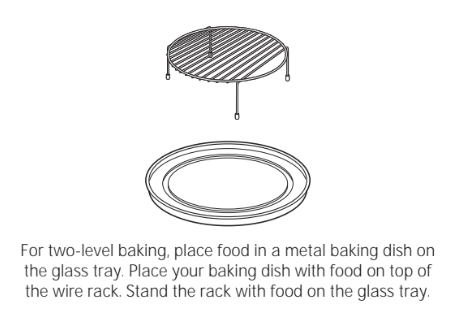
CARE AND CLEANING
Cleaning The Oven
Be sure electrical power is off and all surfaces are cool before cleaning any part of the oven.
Helpful Hints
An occasional thorough wiping with a solution of baking soda and water keeps the inside fresh. Also we recommend against using cleaners with ammonia or alcohol, as they can damage the appearance of the oven. If you choose to use a common household cleaner, first apply the cleaner directly to a clean cloth, then wipe the soiled area.
Control Panel
It's a good idea to wipe the control panel after each use.Clean with mild soap and water or vinegar and water, rinse with clean water and polish dry with a soft cloth.
Do not use abrasive cleansers, strong liquid cleansers, plastic scouring pads or oven cleaners on the control panel—they will damage the finish.
Oven Exterior
Do not use oven cleaners, abrasive cleansers, strong liquid cleansers, steel wool, plastic scouring pads, or cleaning powders on the interior or exterior of the oven.Clean with a mild soap and water or vinegar and water solution. Rinse with clean water and dry with a soft cloth.
When cleaning surfaces, make sure that they are at room temperature and not in direct sunlight.
If stain on the door vent trim is persistent, use a mild abrasive cleaner and a sponge-scrubber for best results. Spillage of marinades, fruit juices, tomato sauces and basting liquids containing acids may cause discoloration and should be wiped up immediately. Let hot surfaces cool, then clean and rinse.
Stainless Steel Surfaces (on some models)
Do not use a steel wool pad; it will scratch the surface.
To clean the stainless steel surface, use warm sudsy water or a stainless steel cleaner or polish. Always wipe the surface in the direction of the grain. Follow the cleaner instructions for cleaning the stainless steel surface.
To inquire about purchasing cleaning products including stainless steel appliance cleaner or polish, read the Assistance and Accessories section at the beginning of this manual.
How To Clean The Upper Oven Interior

Clean the inside of the oven often for proper heating performance.
Some spatters can be removed with a paper towel, others may require a warm soapy cloth. Remove greasy spatters with a sudsy cloth; then rinse with a damp cloth.Do not use abrasive cleaners or sharp utensils on oven walls.
Never use a commercial oven cleaner on any part of your oven.
Do not clean the inside of the oven with metal scouring pads. Pieces can break off the pad, causing electrical shock.
Door Seal
It's important to keep the area clean where the door seals against the oven. Use only mild, nonabrasive detergents applied with a clean sponge or soft cloth.Rinse well.
Removable Turntable

The area underneath the turntable should be cleaned frequently to avoid odors and smoking during a cooking cycle.
The turntable can be broken if dropped. Wash carefully in warm, sudsy water. Dry completely and replace.
To replace the turntable, place its center over the spindle in the center of the oven and turn it until it seats into place (Make sure the smooth side of the turntable is facing up and that its center seats securely on the spindle.)
Cooking Trays And Baking Sheet
To prevent breakage, allow the trays to cool completely before cleaning. Wash carefully in warm, sudsy water or in the dishwasher.
Do not use metal scouring pads or abrasives, as they may damage the finish. A soap-filled scouring pad may be used to clean the trays.

How To Clean The Lower Oven Interior
The interior of your new oven can be cleaned manually or by using the Steam Clean or Self Clean modes.
Spillage of marinades, fruit juices, tomato sauces and basting liquids containing acids may cause discoloration and should be wiped up immediately. Let hot surfaces cool, then clean and rinse.
Manual Cleaning
Do not use oven cleaners, abrasive cleaners, strong liquid cleansers, steel wool, scouring pads, or cleaning powders on the interior of the oven. Clean with a mild soap and water or vinegar and water solution. Rinse with clean water and dry with a soft cloth. When cleaning surfaces, make sure that they are at room temperature.
Steam Clean Mode
Steam clean is intended to clean small spills using water and a lower cleaning temperature than Self Clean. To use the Steam Clean feature, wipe grease and soils from the oven. Pour one cup of water into the bottom of the oven. Close the door. Press the Options pad, select Steam Clean, and then press Start. The oven door will lock. You can not open the door during the 30 minute steam clean as this will decrease the steam clean performance. At the end of the steam clean cycle the door will unlock. Wipe out any excess water and any remaining soil.
Self Clean Mode
Read Self-Cleaning Oven Safety Instructions at the beginning of this manual before using Self Clean Mode. Self-clean uses very high temperatures to clean the oven interior. The oven door will lock when using this feature. Before operating the self-clean cycle, wipe up grease and soils from the oven. Remove all items from the oven other than enameled (dark color) racks. Shiny or silver racks and any cookware or other items should all be removed from the oven before initiating a self-clean cycle. Close the door. Press the Options pad, selectSelf Clean, and a default self-clean time is displayed.The clean time can be changed to 3:00, 4:00, or 5:00 hours by using the selector dial. For heavily soiled ovens, the maximum 5 hour clean time is recommended.If you wish to use the default time, press the Start pad immediately after selecting the Self Clean. The oven will turn off automatically when the self-clean cycle is complete. The door will stay locked until the oven has cooled down. After the oven has cooled down wipe any ash out of the oven.
IMPORTANT: The health of some birds is extremely sensitive to the fumes given off during the self-cleaning cycle of any range. Move birds to another well-ventilated room.
Lower Oven Racks
The racks that were provided with your oven (dark enameled racks, not shiny) may remain in the oven during the self-cleaning cycle without being damaged.
To manually clean racks, use warm, soapy water. Make sure not to wash the rack slides on an extension rack.
If racks become more difficult to remove from the oven, put some vegetable oil on a soft cloth or paper towel and rub onto the oven rack supports. Do not wipe the oil on an extension rack slide.
Periodically, after several self-clean cycles, the extension rack slides may need to be lubricated using the graphite lubricant shipped with your wall oven. To order additional graphite lubricant read the Assistance and Accessories sections at the beginning of this manual.
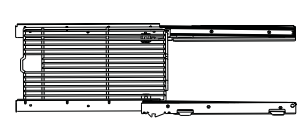
- Remove extension rack from the oven. See the Extension Oven Racks section.
- Fully extend the rack on a table or countertop. Newspaper may be placed underneath the rack for easy clean up.
- If there is debris in the slide tracks, wipe it away using a paper towel. NOTE: Any graphite lubricant wiped away must be replaced.
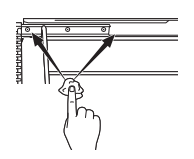
- Shake the graphite lubricant before opening it. Starting with left slide mechanism of the rack, place four (4) small drops of lubricant on the two (2) bottom tracks of the slide close to the bearing carriers.
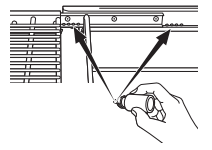
- Repeat for the right slide mechanism of the rack.
- Open and close the rack several times to distribute the lubricant.
- Replace the cap on the lubricant and shake it again. Turn the rack over and repeat steps 3, 4, 5 and 6.
- Close the rack, turn rack right-side-up and place in the oven. See the Extension Oven Racks section.
- Repeat above steps for each rack.
NOTE: Do not spray with cooking spray or other lubricant sprays.
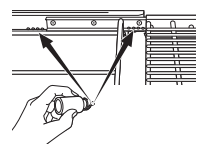
Lower Oven Maintenance
Lower Oven Light Replacement
- Disconnect power at the main fuse or circuit breaker panel.
- Remove oven racks.
- Slide a flat blade screwdriver between the housing and the glass light cover.
- Support the glass light cover with two fingers to prevent the cover from falling to the bottom of the oven. Be careful not to chip the oven coating.
- Gently twist the screwdriver blade to loosen the glass light cover.
- Remove the glass light cover.
- Remove the bulb by firmly grasping and sliding the bulb straight out until the two prongs have cleared the ceramic holder.
- Do not touch the glass of the new replacement bulb with your fingers. It will cause the bulb to fail when it lights. Grasp the replacement bulb with a clean towel AN or facial tissue with the prongs facing down. Align ASR the two prongs in the ceramic holder, pressing gently until the bulb is securely in the ceramic socket.
- Slide the protective lens into the holder and push until the clips snap into the housing.
- Reconnect power.
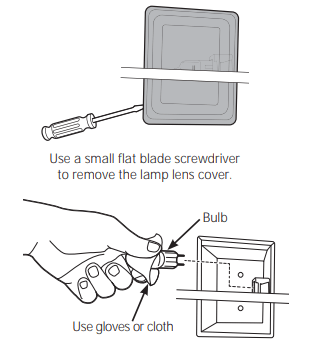
Lift-Off Lower Oven Door
The door is very heavy. Be careful when removing and lifting the door.
Do not lift the door by the handle.
To remove the door:
1. Fully open the door.
2. Pull the hinge locks down toward the door frame, to the unlocked position. A tool, such as a small flatblade screwdriver, may be required.
3. Firmly grasp both sides of the door at the top.
4. Close door to the door removal position. The door should be open approximately 3" with no obstruction above the door.
5. Lift door up and out until both hinge arms are clear of the slots.

To replace the door:
1. Firmly grasp both sides of the door at the top.
2. Starting on the left side, with the door at the same angle as the removal position, seat the indentation of the hinge arm into the bottom edge of the hinge slot. The notch in the hinge arm must be fully seated into the bottom of the slot. Repeat for right side.
3. Fully open the door. If the door will not fully open, the indentation is not seated correctly in the bottom edge of the slot.
4. Push the hinge locks up against the front frame of the oven cavity, to the locked position.
5. Close the oven door.

TROUBLESHOOTING TIPS
FAN
Fan continues to run after cooking stops
- The oven is cooling.
- The fan will automatically shut off when the internal parts of the oven have cooled.
Oven vent emits warm air while oven is on
- This is normal.
Fan comes on automatically when using the microwave
- This is normal.
COOKING
The oven makes unusual sounds while cooking
- Clicks and fans blowing are normal. The relay board is turning the components on and off.
- These sounds are normal.
Smoke comes out of the oven when I open the door
- Food is high in fat content. Aerosol spray used on the pans.
- Smoke is normal when cooking high-fat foods.
Food is not fully cooked or browned at the end of a cooking program
- Programmed times may not match the size or amount of food you are cooking.
- Adjust time for doneness or adjust the upper or lower lamps for browning and doneness.
SENSOR ERROR displayed along with an oven signal
- Food amount or type placed in the oven does not match the program that was set.
- Press the Clear/Off pad. Set the oven program to match the food or liquid to be cooked or heated.
- Steam was not sensed by the oven because plastic wrap was not vented, a lid too tight was on the dish or a liquid was covered.
- Vent plastic wrap, use a looser lid or uncover liquids when cooking or heating.
DISPLAY
The display is blank
- Power saver mode may be activated.
- Check the Settings menu for clock display settings. Turn the display on.
- A fuse in your home may be blown or the circuit breaker tripped.
- Replace the fuse or reset the circuit breaker.
- Power outage or surge
- Reset the clock. If the oven was in use, you must reset it by pressing the Clear/Off pad, setting the clock and resetting any cooking function.
“Control is LOCKED” appears in display
- The control has been locked.
- Press and hold Settings pad for 3 seconds to unlock the control.
Control display is lit yet oven will not start
- Clock is not set.
- Set the clock.
- Door not securely closed.
- Open the door and close securely.
- Start/Pause pad or selector dial not pressed after entering cooking selection.
- Press Start/Pause pad or selector dial.
- Another selection already entered in oven and Clear/Off pad not pressed to cancel it.
- Press Clear/Off pad.
- Size, quantity or cooking time not entered after final selection.
- Make sure you have entered cooking time after selecting.
- Clear/Off pad was pressed accidentally.
- Reset cooking program and press Start/Pause pad.
OTHER PROBLEMS
The door and inside of the oven feels hot in a small space.
- The heat lamps produce intense heat
- This is normal. Use oven mitts to remove food when ready.
Oven will not start
- A fuse in your home may be blown or the circuit breaker tripped.
- Replace fuse or reset circuit breaker.
Cannot edit cooking features performance.
- Some pre-programmed cooking features may not be able to be edited to prevent degradation of cooking
- This is normal.
The pads on one side of the control do not function
- The control has locked out the use of these pads and need to be reset.
- Press and hold the Clear/Off pad on the other side of the display for 30 seconds. If this does not reset the control, it may be necessary to cycle the circuit breaker.
FCC RADIO FREQUENCY INTERFERENCE
This equipment generates and uses ISM frequency energy and if not installed and used properly, that is in strict accordance with the manufacturer's instructions, may cause interference to radio and television reception. It has been type tested and found to comply with limits for an ISM Equipment pursuant to part 18 of FCC Rules, which are designed to provide reasonable protection against such interference in a residential installation. However, there is no guarantee that interference will not occur in a particular installation. If this equipment does cause interference to radio or television reception, which can be determined by turning the equipment off and on, the user is encouraged to try to correct the interference by one or more of the following:
- Reorient the receiving antenna of radio or television.
- Relocate the Microwave oven with respect to the receiver.
- Move the microwave oven away from the receiver.
- Plug the microwave oven into a different outlet so that microwave oven and receiver are on different branch circuits.
The manufacturer is not responsible for any radio or TV interference caused by unauthorized modification to this microwave oven. It is the responsibility of the user to correct such interference.
My new oven doesn't cook like my old one. Is something wrong with the temperature settings?
- Your new oven has a different cooking system from your old oven and therefore may cook differently than your old oven.
- For the first few uses, follow your recipe times and temperatures carefully. If you still think your new oven is too hot or too cold, you can adjust the temperature yourself to meet your specific cooking preference. NOTE: This adjustment affects Bake, Convection Bake 1 Rack and Convection Bake Multi temperatures; it will not affect Convection Roast, Broil, or Clean.
Food does not bake properly
- Oven controls improperly set.
- See the Cooking Modes section.
- Rack position is incorrect or rack is not level.
- See the Cooking Modes section and Cooking Guide.
- Incorrect cookware or cookware of improper size being used.
- See the Cookware section.
- Oven temperature needs adjustment.
- See the Settings section.
- Ingredient substitution
- Substituting ingredients can change the recipe outcome.
Food does not broil properly
- Oven controls improperly set.
- Make sure you select the appropriate broil mode.
- Improper rack position being used.
- See Cooking Guide for rack location suggestions.
- Food being cooked in a hot pan.
- Make sure cookware is cool.
- Cookware not suited for broiling.
- Use a pan specifically designed for broiling.
- Aluminum foil used on the broiling pan and grid has not been fitted properly and slit as recommended.
- If using aluminum foil conform to pan slits.
- In some areas the power (voltage) may be low.
- Preheat the broil element for 10 minutes.
Oven temperature too hot or too cold
- Oven temperature needs adjustment.
- See the Settings section.
Oven does not work or appears not to work
- A fuse in your home may be blown or the circuit breaker tripped.
- Replace the fuse or reset the circuit breaker.
- Oven controls improperly set.
- See the Using the Oven section.
- Oven is in Sabbath Mode.
- Verify, that the oven is not in Sabbath Mode. See the Sabbath Mode section.
“Crackling” or“popping” sound
- This is the sound of the metal heating and cooling during both the cooking and cleaning functions.
- This is normal.
Why is my range making a "clicking" noise when using my oven?
- Your range has been designed to maintain a tighter control over your oven's temperature. You may hear your oven's heating elements "click" on and off more frequently than in older ovens to achieve better results during baking, broiling, convection, and self-clean cycles.
- This is normal.
Clock and timer do not work
- A fuse in your home may be blown or the circuit breaker tripped.
- Replace the fuse or reset the circuit breaker.
Oven light does not work
- Light bulb is loose or defective.
- Tighten or replace bulb.
- Pad operating light is broken.
- Call for service.
Oven will not self- clean
- The temperature is too high to set a self-clean operation.
- Allow the oven to cool and reset the controls.
- Oven controls improperly set.
- See the Cleaning the Oven section.
Excessive smoking during clean cycle
- Excessive soil or grease.
- Press the Clear/Off pad. Open the windows to rid the room of smoke. Wait until the OVEN IS COOLING DOOR IS LOCKED display goes off. Wipe up the excess soil and reset the clean cycle.
Excessive smoking during broiling
- Food too close to burner element.
- Lower the rack position of the food.
Oven door will not open after a clean cycle
- Oven too hot.
- Allow the oven to cool below locking temperature.
Oven not clean after a clean cycle
- Oven controls improperly set.
- See the Cleaning the Oven section.
- Oven was heavily soiled.
- Clean up heavy spillovers before starting the clean cycle. Heavily soiled ovens may need to self-clean again or for a longer period of time.
"CLOSE DOOR TO CONTINUE COOKING" show on display section
- The door is open during a cooking or cleaning feature.
- Close the oven door.
"OVEN IS COOLING DOOR IS LOCKED" show on display section
- The oven door is locked because the temperature inside the oven has not dropped below the unlocking temperature.
- Press the Clear/Off pad. Allow the oven to cool.
An oven error and "SERVICE MAY BE NEEDED" show in the display
- You have a function error code.
- Press the Clear/Off pad. Allow the oven to cool for one hour. Put the oven back into operation.
- If the function code repeats.
- Disconnect all power to the oven for at least 30 seconds and then reconnect power. If the function error code repeats, call for service.
"Burning” or “oily” odor emitting from the vent
- This is normal in a new oven and will disappear in time.
- To speed the process, set a self-clean cycle for a minimum of 3 hours. See the Cleaning the Oven section.
Strong odor
- An odor from the insulation around the inside of the oven is normal for the first few times the oven is used.
- This is temporary and will go away after several uses or a self-clean cycle.
Fan noise
- A cooling fan may automatically turn on.
- This is normal. The cooling fan will turn on to cool internal parts. It may run for up to 1-1/2 hours after the oven is turned off.
My oven door glass appears to be "tinted" or have a "rainbow" color. Is this defective?
- No. The inner oven glass is coated with a heat barrier to reflect the heat back into the oven to prevent heat loss and keep the outer door cool while baking.
- This is normal. Under certain light or angles, you may see this tint or rainbow color.
Sometimes the oven takes longer to preheat to the same temperature
- Cookware or food in oven
- The cookware or food in the oven will cause the oven to take longer to preheat. Remove items to reduce preheat time.
- Number of racks in oven
- Adding more racks to the oven will cause the oven to take longer to preheat. Remove some racks.
- Different cooking modes
- The different cooking modes use different preheat methods to heat the oven for the specific cooking mode. Some modes will take longer than others (i.e. convection bake multi).
See other models: GFW148SSMWW JGB660EEJES JB750EJES JGBS60REKSS JGBS10DEMWW

